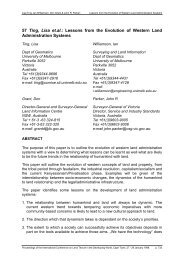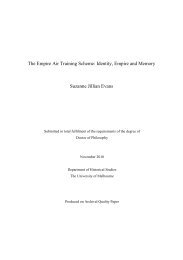Speculum - University of Melbourne
Speculum - University of Melbourne
Speculum - University of Melbourne
You also want an ePaper? Increase the reach of your titles
YUMPU automatically turns print PDFs into web optimized ePapers that Google loves.
36 SPECULUM<br />
emancipation. That day came in 1896,<br />
when Freda Gamble and Janet Greig, who<br />
had attended the <strong>Melbourne</strong> Hospital<br />
clinical school, finished their courses in<br />
fourth and sixth places, and applied for resident<br />
<strong>of</strong>fice at the hospital. The "Argus",<br />
which opposed the appointment <strong>of</strong> the<br />
ladies, alleged that patients in the hospital,<br />
whether male or female, colonial born or<br />
English, were seething, and threatening to<br />
leave the wards to escape the touch <strong>of</strong> a<br />
woman. In other newspapers the ladies<br />
stated their case ably. Dr. Gamble said<br />
that the hospital should never have accepted<br />
their clinical fees if it did not intend to<br />
admit them to <strong>of</strong>fice once their examination<br />
results qualified them for appointment. The<br />
only case against them, she said, rested on<br />
prejudice and pr<strong>of</strong>essional jealousy: "We<br />
have beaten the men and they do not like<br />
it." The committee <strong>of</strong> management could<br />
not turn away these two applicants, graduates<br />
in its own hospital, as easily as it had<br />
rejected Dr. Stone. Some members <strong>of</strong> the<br />
committee had approved the appointment <strong>of</strong><br />
lady doctors even in 1892, when Dr. Whyte<br />
seemed likely to apply: "If ladies . . . suffered<br />
a number <strong>of</strong> conveniences," said a<br />
member who supported them, "then these<br />
were for the consideration <strong>of</strong> the ladies<br />
themselves." This attitude became more<br />
common in the hospital by 1896, especially<br />
as the two ladies had proved their competence.<br />
Others on the committee <strong>of</strong> management<br />
may have been intimidated by Dr.<br />
Gamble's charge that she and Dr. Greig<br />
could be refused only if it were true that<br />
the male rulers <strong>of</strong> the hospital resented their<br />
success. With varying degress <strong>of</strong> enthusiasm,<br />
the men <strong>of</strong> the hospital agreed to admit<br />
its first female medical <strong>of</strong>ficers.<br />
CITRADEX<br />
• THE MULTI-VITAMIN SYRUP<br />
WITH THE FRESH FRUIT<br />
FLAVOUR<br />
II ALL THE FAMILY WILL LIKE<br />
CITRADEX<br />
Another product <strong>of</strong> the<br />
GLAXO LABORATORIES<br />
Teaching at the hospital remained<br />
neither wholly incompetent nor wholly satisfactory.<br />
If they were attached to Williams<br />
or Fitzgerald, students could not help being<br />
instructed and inspired. In 1891, however,<br />
the city coroner, Dr. Richard Youl,<br />
who seldom criticised irresponsibility, was<br />
still able to remark that students at the hospital<br />
had to pick up knowledge as best they<br />
could. The cause was well known. Despite<br />
an improvement in its relations with<br />
the hospital, the university still had to<br />
choose its clinical lecturers from a body <strong>of</strong><br />
doctors whose election lay in the hands <strong>of</strong><br />
charitable subscribers. This obstacle was<br />
finally overcome in 1910, when the right to<br />
elect honorary medical <strong>of</strong>ficers passed from<br />
subscribers to the committee <strong>of</strong> management.<br />
The university council and the<br />
faculty <strong>of</strong> medicine were both represented<br />
after 1910 on an advisory board which was<br />
established to recommend candidates for<br />
election. The hospital and the university<br />
could at last work closely together in the<br />
training <strong>of</strong> doctors, for students could now<br />
be given clinical instruction by honorary<br />
medical <strong>of</strong>ficers appointed for their skill as<br />
teachers. An <strong>of</strong>ficial channel joined theory<br />
and practice in the medical course.<br />
Yet, despite the caprice <strong>of</strong> the old electoral<br />
system, teaching at the hospital improved<br />
remarkably between 1900 and<br />
1910, owing to the ability and devotion <strong>of</strong><br />
particular teachers. Williams was no longer<br />
very active, but there were now more men<br />
at the hospital who shared his mastery <strong>of</strong><br />
two sets <strong>of</strong> techniques—who were able<br />
practitioners and successful teachers.<br />
Among the surgeons, G. A. Syme, G. C.<br />
Rennie, F. D. Bird and R. A. Stirling had<br />
replaced the men who fought out the<br />
Listerian controversy; each <strong>of</strong> them taught<br />
his students as capably as he tended his<br />
patients. But it was a physician, Dr. R. R.<br />
Stawell, who made the greatest impact on<br />
the hospital clinical school. Like his contemporary,<br />
Henry Maudsley, Stawell owed<br />
much <strong>of</strong> his skill as a teaching physician to<br />
post-graduate training at <strong>University</strong> College,<br />
London, which had the only medical<br />
school in England comparable with those in<br />
Scottish and European universities. Sir<br />
Alan Newton spoke thus <strong>of</strong> Stawell's English<br />
training during his Stawell Oration in<br />
1947: "He returned from England in the<br />
'nineties <strong>of</strong> the last century, deeply

















